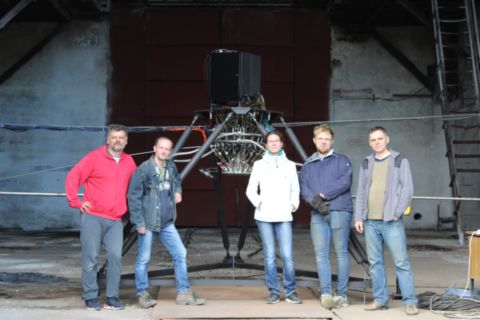Since 2021, scientists at South Ural State University, with the expert support from Joint Stock Company Academician V.P. Makeyev State Rocket Centre, are developing a demonstrator of a propulsion system for the first Russian single-stage vertical take-off and landing reusable launch vehicle. Recently, the researchers have engineered a unique mechanism for regulation of the direction of motion for a demonstrator of a landing module equipped with a multiple-chamber propulsion system with a profiled central body. This approach has allowed not only to simplify the engine design, but also to make it more lightweight (by 3%) and reduce the fuel consumption.
Engine thrust is generated by a jet stream: its speed, pressure and force determine the axial direction of a launch vehicle during its flight. To make the launch vehicle rotate, one must change the thrust direction along its rolling axis.
Traditionally, this is achieved by the rocket engine chambers movement with the help of the additionally mounted heavy control actuators or gimbals.
The developers from Chelyabinsk managed to make the engine design more lightweight by 3% by abandoning the mechanical control units; each such percent has a positive effect on the flight range of a vehicle and on the payload mass on-board. Several chambers were located peripherally around the profiled (with special grooves to direct the exhaust gases) central body.
“Using such an approach, we form a single exhaust jet, meanwhile it becomes possible to augment/reduce the thrust in separate chambers in different control planes,” shared Aleksei Shults, design engineer of the Research Laboratory for Aircraft Propulsion and Power Systems. “If the thrust in one chamber reduces, then the thrust in another, opposite chamber augments automatically. Namely this thrust imbalance along the rolling axis ensures the deviating moment of the engine mass centre, and thus of the launch vehicle itself – it turns in the desired direction. It is important that you can control both single chambers and groups of chambers as well.”
To regulate the thrust in separate chambers, the developers were changing the alcohol flow rate in the “gaseous oxygen and alcohol” propellant system.
In the course of the experiment with the demonstrator, the electronic fuel flow regulators, upon the command from the control system, either increased or reduced the alcohol flow rate in order to achieve the relevant values of thrust in separate blocks of chambers. The researchers note that such an approach allows to save the resource of one of the fuel components by up to 5%. This project is being fulfilled within the frameworks of the Ural Interregional Research and Education Centre (UIREC).




